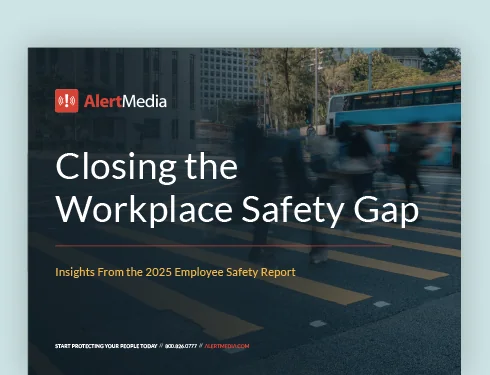
Preparing Your Business for Every Stage of a Pandemic
Experts agree that there will most likely be three stages to this pandemic. Read this article to learn how your business can prepare for every stage.

The COVID-19 pandemic has created an unparalleled time of uncertainty. It seems that nothing can be taken for granted anymore—from basic human interaction to the supply of toilet paper.
Epidemiological forecasters have tried to satisfy this need for certainty by building models to predict the spread of the disease. But these models often tell very different stories and can be hard to digest.
However, if one takes a step back and looks at pandemics broadly, there starts to be some agreement. Even though people disagree about when or how we should “reopen the economy,” just about everybody agrees on one thing: there are three stages of a pandemic. Let’s discuss what you can expect in each of those three stages, and how your business can prepare for every stage of a pandemic.
Stage One: Extreme Social Distancing
At this point, most of us are very familiar with Stage One. During this stage of a pandemic, the disease is at risk of spreading rapidly. To keep the healthcare system from being overwhelmed, the focus must turn to flattening the curve, which can only be accomplished by extreme social distancing.
There are several key characteristics of this stage that your business must prepare for:
Remote working
During this stage, most areas will be under “shelter-in-place” or another similarly restrictive governmental order. Only “essential businesses” will be allowed to continue in-person operations, which means that all other businesses must switch to remote working.
Although this could fill up an article on its own, here are a few steps every business should consider taking to support its transition to remote working:
- Implement productivity tools (e.g. Slack, Zoom, etc.)
- Mitigate social isolation with remote team activities
- Establish daily check-ins
- Be understanding about employees with distractions at home
- Offer encouragement and emotional support
Supply chain disruption
Another difficult side-effect of a global pandemic is the ripple effect it causes on supply chains worldwide. Countries are going to be hit by the disease at different times, meaning that your supply chain may be disrupted well before (or well after) the disease has begun to spread in your country. This means you cannot wait until the disease is at your country’s doorstep to reach out to suppliers. At that point, it may be too late. Proactive measures to enhance supply chain resilience can turn crises into opportunities for growth and innovation.
Ideally, your company has performed network mapping to identify the physical locations of every stop on your supply chain. This is a huge advantage in the early stages of a pandemic, but the reality is that most companies have not performed this analysis. If your organization is in that position when an outbreak occurs, you have no choice but to start assessing the situation manually. Be proactive in reaching out to suppliers; the sooner you can expect disruption, the better prepared you will be when it comes.
Because countries are on different timelines, supply chain disruption can last well into the next two stages—as other countries may only be at the beginning of their outbreak. Don’t assume your suppliers are on the same timeline as you. They may, in fact, be back in business well before you—or vice versa.
New delivery methods
On the product side, many companies can expect to resort to new delivery methods during Stage One of a pandemic. If you sell products at a physical storefront or provide in-person services, you will likely need to find new ways to provide those products or services.
Many companies are getting creative with alternative delivery methods—using Zoom calls and contactless delivery methods to serve consumers and also give them peace of mind. It is crucial to make these new delivery methods explicit in marketing materials and customer communications, so that customers know they can still get the product or service they want without risking their personal health.
Wellness checks
Social distancing is necessary to stop the spread of disease in the early stages of a pandemic, but it is also incredibly taxing. Studies have shown that the loneliness caused by social distancing produces a neurological response akin to hunger. People are literally “starving” for human interaction.
As an organization with remote employees, you must recognize this reality. The best way is to conduct periodic “wellness checks” on all employees. Ideally, these wellness checks should be face-to-face (even if over video chat), but that is obviously not always feasible.
The best policy is to incorporate several different types of wellness checks. Encourage managers to perform periodic check-ins with their employees face-to-face, over video call. But you should also provide company-wide wellness checks from leadership. By using your company’s emergency communication system, you can send out company-wide surveys checking on employees’ well-being and mental health, to try to identify anyone who is slipping through the cracks. This will let employees hear straight from the top that their organization is looking out for them.
If one of your employees is having a particularly hard time, offer them a mental health day, where they can go outside (if local laws allow), video-conference with friends and family, and recharge. Adopting this policy will go a long way to keeping your employees healthy and productive during Stage One of a pandemic.
Stage Two: Relaxed Social Distancing
The next stage of a pandemic comes when a country (or state) has passed the peak of the curve and can begin relaxing social distancing gradually as it attempts to reopen its economy. The problem is, during Stage Two there is still no vaccine—meaning that the only ones who are potentially immune are those who have contracted the disease already (and even that is still uncertain). If the social distancing restrictions are lifted too quickly or in the absence of large-scale controls, then the country risks the onset of another mass outbreak and another curve that needs to be flattened—sending them back to Stage One.
When it comes to the COVID-19 pandemic specifically, experts agree that massive controls will need to be in place before the country can return to anything resembling “normal life.” This will likely involve some combination of 1) mass testing and 2) mass surveillance—although the extent of each is up for debate.
Regardless, Stage Two will be defined by several key characteristics which your business must prepare for:
Selective quarantining
While Stage One is defined by shelter-in-place orders and workforce-wide remote working, Stage Two will see the (gradual) lifting of quarantines. However, selective quarantining will remain in place for the entirety of Stage Two. Whenever anyone tests positive, they—plus anyone they have come into contact with—will likely be under mandatory quarantine for two weeks. Additionally, at-risk populations should also remain under quarantine during Stage Two. This “selective quarantining,” while far less pervasive than community-wide quarantine, will still have a massive effect on eliminating the spread of the virus.
From an organizational perspective, this reality almost requires you to be more agile than during community-wide quarantine. You need to be ready to return a majority of employees to the office when guidelines allow, but also need to accommodate those who must remain in quarantine. In other words, you need to be ready to support hybrid working—where a majority of employees are working in-person, but those who are not aren’t left feeling isolated from their colleagues.
Heightened health concerns
As you prepare for employees to return to the office, you must also prepare for a very different working environment than existed before the pandemic. Since there will still be no vaccine for the disease, health concerns are at the top of mind. Here are a few steps you should take:
- Strongly encourage employees to wash hands properly and regularly
- Strongly discourage handshakes and other unnecessary physical contact
- Install hand sanitizer dispensers around the office
- Consider ways that you can “socially distance” your physical office space
- Tell employees to stay home if experiencing any symptoms
These steps will be critically important during the uncertain in-between time when employees return to work but there is no vaccine.
Preparing for a positive test
Your organization also needs to be prepared for the worst case-scenario: what if an employee tests positive for the disease? If this happens, your organization will likely only have one option: Quarantine all employees who potentially came into contact with that person.
While taking the proper health precautions should minimize the number of infections, quarantining is still the only recourse when there is known exposure to a positive test case in Stage Two. This means that your organization needs to be agile enough to switch a large portion of the workforce to remote working immediately—ideally with as little disruption as possible. Tell employees to keep their remote working environments intact, and don’t abandon the productivity tools you adopted during the remote working period in Stage One.
But it also means that your company cannot afford to go back to “business as usual” when you return to the office. You need to take steps to ensure that a positive test does not cripple your business by quarantining or infecting a huge portion of your workforce. Here are a few measures you can take to mitigate this risk:
- Ensure redundancy. In this situation, redundancy trumps efficiency. By cross-training employees and identifying people who can fill in on a contract basis, you will ensure that a cluster of positive infections does not leave a gaping hole in your operations.
- Form succession plans. This goes for a variety of roles—not just senior leadership. You need to know who is going to fill the shoes of an employee if they are out of commission for two weeks.
- Split operations. Even when your office can re-open, it likely doesn’t make sense to bring entire teams back together to one physical office location. For large organizations, this will be easier to accomplish. But for smaller companies, consider bringing back only half of each team—or rotating who works from home. This ensures that one positive test won’t take out an entire team.
Obviously, you hope that you will never have to face this sort of situation. But if you do not take the necessary precautions, you risk one positive test blindsiding your business.
Following changing guidelines
Stage Two is, in many ways, more dynamic than Stage One. Social distancing guidelines will be gradually lifted across the country—likely differing on a state-by-state (or even a county-by-county) level. It is critical that your organization stays up to date on the changing federal, state, and local guidelines throughout Stage Two. This can be incredibly difficult, especially for organizations with offices in multiple states or countries.
Using a threat monitoring system like AlertMedia’s, which compiles the latest guidelines at every level, allows you to see only those that are relevant to your organization—where offices or employees are located. This gives you the information you need without requiring you to sift through contradictory information and clunky government websites.
The potential second wave
Ideally, Stage Two proceeds directly into Stage Three. Unfortunately, that is not always the case. Before the development of a vaccine, there is always the risk of a new outbreak, a “second wave” of cases triggering a new curve that needs to be flattened.
This can happen for a variety of reasons. One factor can be weather. In the case of the Spanish Flu of 1918, the disease subsided during the hot summer months, then returned in the fall—killing many more than were killed in the “first wave.” Another factor can be temporary immunity. Many diseases, like the seasonal flu or the common cold, only grant the infected person temporary immunity. If this time period is only a matter of months, then everyone that was infected in the first wave is no longer immune just months after it subsides. This leaves a high probability that a new wave will sweep through the population, since it will be difficult or impossible to develop herd immunity.
So what does this mean for your business? It means that Stage One is never truly in the past until a vaccine is widely available. So if there were aspects of your organization’s Stage One response that were sub-optimal, resist the urge to sweep them under the rug. Identify where your response could have been better, propose solutions, and try to implement as many as possible in case a second wave is in the cards.
Stage Three: Widespread Immunity
The final stage of a pandemic, Stage Three, comes when the community is able to achieve widespread immunity. There are several ways to accomplish this, including preventing transmission or achieving herd immunity, but the most likely route is developing a vaccine. It is often impossible to prevent transmission if the disease is airborne or spreads through brief physical contact, and herd immunity often comes at a great price—since a large majority of the population must be infected. On top of that, herd immunity only works for diseases that provide lifetime immunity, which is often not the case.
Vaccines, however, enable widespread immunity no matter how the disease spreads or how long one has immunity after being infected. In the absence of a vaccine, the country will almost inevitably be stuck in Stage One or Stage Two—either trying to flatten the curve or avoid a new one. But once a vaccine is deployed, the pandemic is finally in its final days.
For COVID-19, most experts predict this day is far in the future. Vaccine development is a long process, and even an accelerated pace is not predicted to yield results in 2020. However, it is worth your time to start preparing your company for when that day does come.
Encouraging vaccination
It almost goes without saying, but your company’s first priority should be encouraging all your employees to vaccinate (if they can do so safely). There will likely be a gradual roll-out, as the vaccine is developed and deployed. But you should make sure that your employees understand the importance of getting the vaccine.
One important caveat, however, is that encouragement is likely all that you will be legally permitted to do. While there are exceptions, the general rule is that employers cannot require employees to vaccinate. This may be a non-issue, if there are state or federal requirements to vaccinate, but it is still important to keep your rights as an employer in mind.
Returning to (a new) normal
Finally, once the vaccine is widely deployed, it is time for things to return to “normal.” But the world—and your business—will never (and should never) be completely the same as it was before the pandemic. Global disasters and recessions often give rise to the greatest innovations, and your company should not be so focused on returning to normal that you turn a blind eye to the discoveries you made and the lessons you learned during the pandemic.
Ask yourself:
- In what ways was our organization well-prepared for the pandemic?
- In what ways could we have been better prepared?
- How productive was remote working as opposed to in-person working?
- What health practices are worth keeping even after the pandemic?
- Is it worth keeping the alternative delivery methods we developed?
- Did we uncover any important product innovations?
Make sure that all the levels of your organization get in on this conversation. Hearing as many perspectives as possible will help your company decide which preparations were lacking, which ones worked, and which changes should be made permanent.
Communication during every stage
Although looking ahead is uncertain, identifying a path ahead of us is helpful—even if we don’t know all the details. By preparing your business to take the appropriate steps above, you put yourself in the best position to keep your business running smoothly and your people healthy and productive, through every stage of the pandemic.
Make sure your company is equipped to weather every stage. In any crisis, that primarily comes down to communication. In a remote working environment, communication solutions are more important than ever. Productivity apps like Slack and Zoom are must-haves, as is an emergency communication system like AlertMedia, which will enable company-wide notifications and wellness checks. A system like AlertMedia will also pay dividends when other critical events impact your business—both during and after the pandemic—like hurricanes, wildfires, and winter storms. This is a difficult time: Make sure your organization has the solutions it needs to get through it.




